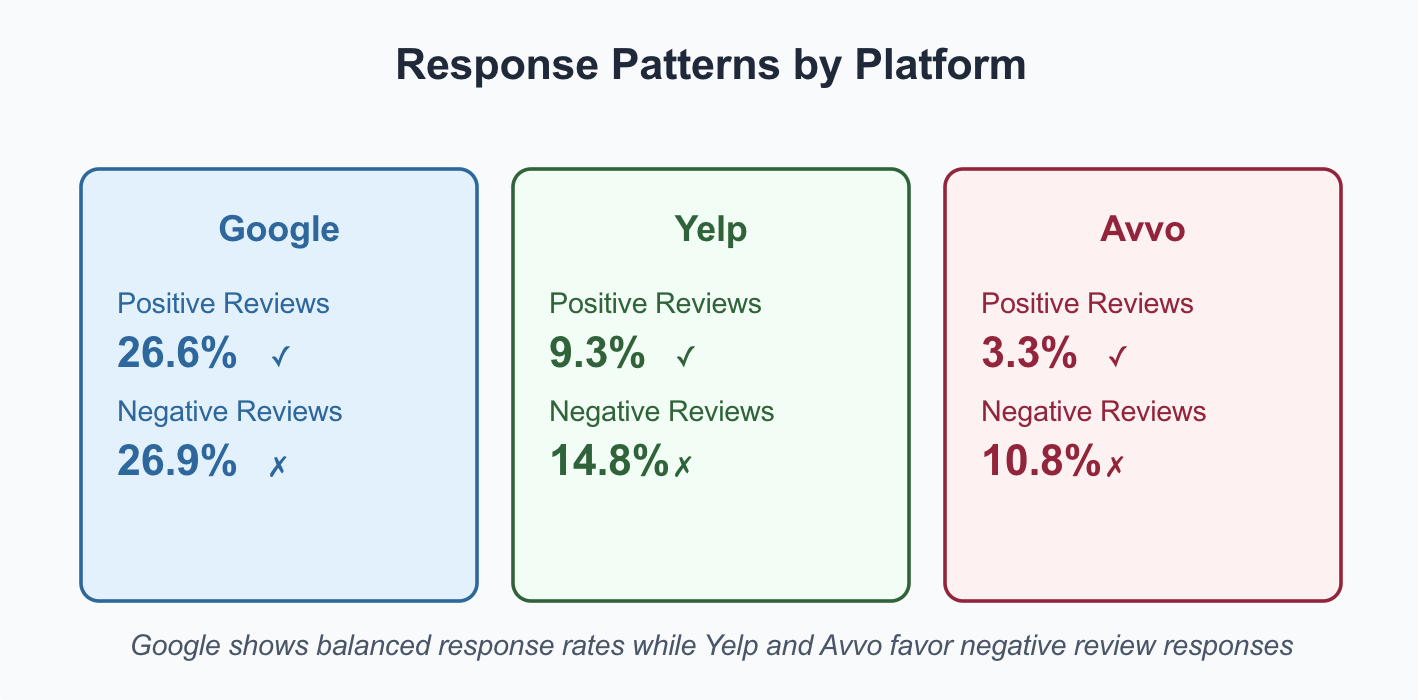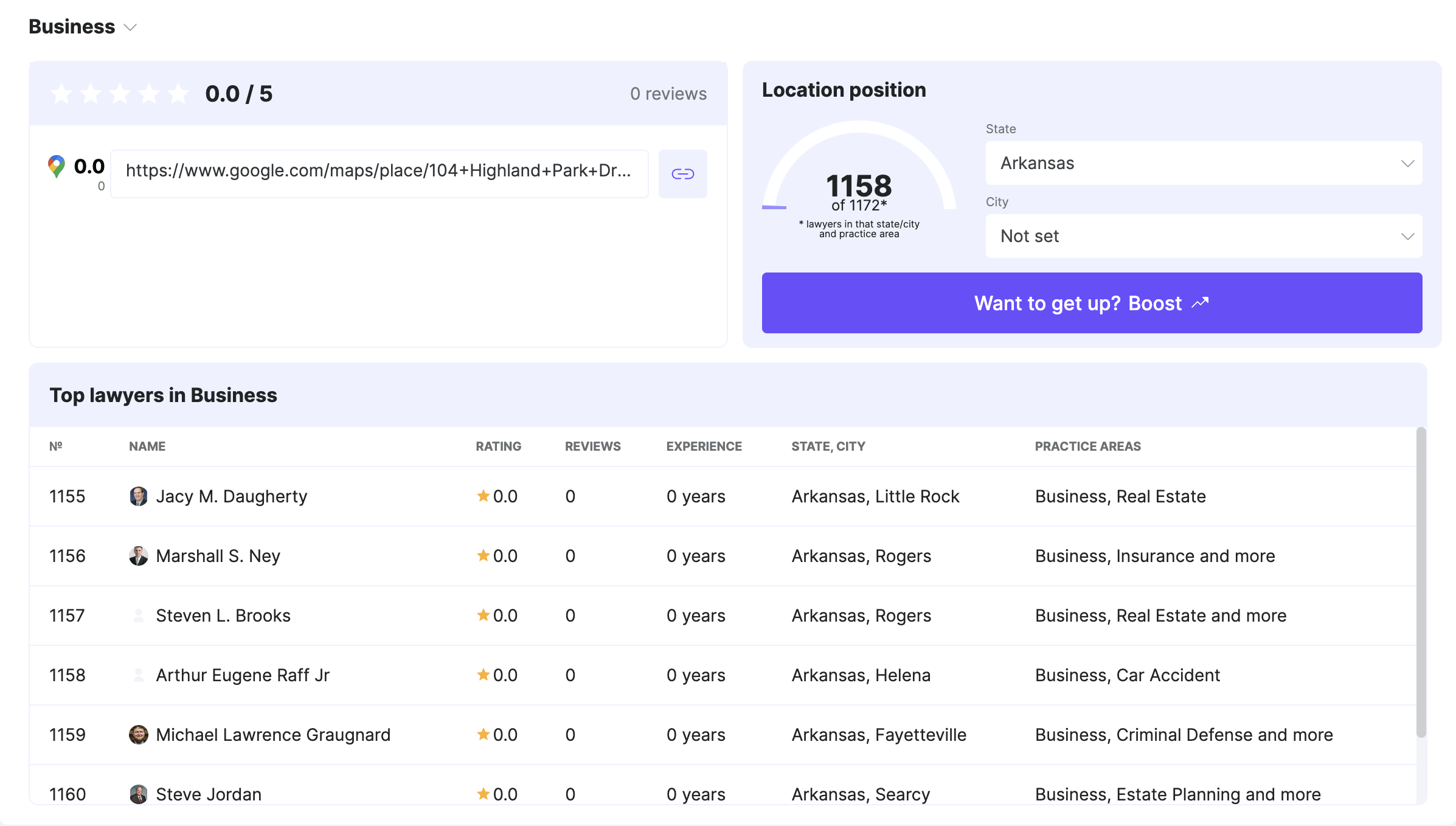Digital Reputation Disparity Study 2025: A Deep Dive into 9.8 Million Lawyer Reviews

I've analyzed an 9.8 million reviews across Google, Yelp, and Avvo to bring you the most comprehensive analysis of client satisfaction in the legal industry.
The Big Picture: Platform Dynamics
The legal services review landscape is dominated by Google, with a staggering 8,488,424 reviews, dwarfing both Avvo (912,118) and Yelp (290,081). However, raw numbers don't tell the whole story. Each platform shows distinct patterns that reveal fascinating insights about how clients rate and review their legal experiences.
Rating Patterns Across Platforms
Interestingly, while Avvo leads with the highest average rating of 4.68 out of 5, followed closely by Google at 4.63, Yelp shows a notably lower average of 4.14. This disparity raises questions about platform-specific review cultures and verification processes.
The distribution of ratings tells an even more intriguing story:
- Avvo: 92.1% positive reviews (4-5 stars)
- Google maps: 90.9% positive reviews
- Yelp: 78.4% positive reviews
Response Rate Patterns Across Review Platforms
Our analysis of response rates across Google Maps, Avvo, and Yelp reveals fascinating patterns in how businesses engage with their reviews. The data shows distinct engagement strategies across different rating levels and platforms.
Google Maps leads with the highest overall engagement, showing a unique U-shaped response pattern. Businesses are most active in responding to 5-star reviews (35.97%) and 1-star reviews (30.41%), while maintaining lower response rates for middle-range reviews. This suggests a strategic focus on acknowledging extremely positive feedback while also addressing critical reviews.
Yelp demonstrates a more balanced approach, with response rates ranging from 9.26% for 5-star reviews to 16.35% for 2-star reviews. Notably, businesses show increased engagement with critical reviews, maintaining response rates above 13% for ratings of 3 stars and below.
Avvo presents the most conservative response strategy, with generally lower engagement rates across all ratings. The platform shows higher response rates for critical reviews (11.81% for 3-star reviews) compared to positive ones (3.64% for 5-star reviews), suggesting a focus on addressing concerns rather than acknowledging praise.
Analysis of Attorney Ratings: What the Numbers Tell Us
Analysis of attorney ratings reveals interesting patterns in how clients rate their legal representatives. I've analyzed the lawyers and legal companies who have at least one reviews on the major review platforms.
Rating Segments
- Top tier (4.5-5.0): 68.69% (251,630 lawyers and legal companies)
- Mid-tier (3.5-4.49): 16.46% (60,268 lawyers and legal companies)
- Lower tier (Below 3.5): 14.85% (54,424 lawyers and legal companies)
Statistical Anomalies
- Higher proportion of extremely low ratings (Below 2.0: 7.19%) compared to moderate-low ratings (2.0-2.99: 2.65%)
- Perfect rating (5.0) represents majority, suggesting possible rating inflation or selection bias
Market Segmentation
- Clear differentiation between top-rated (4.5+) and other attorneys
- Significant gap between high and low-rated attorneys
- Potential opportunity for improvement in lower-rated segments
LEGAL INDUSTRY RATING SNAPSHOT
February 2025 Analysis
187,233 lawyers (51.11%)
64,397 lawyers (17.58%)
41,892 lawyers (11.44%)
18,376 lawyers (5.02%)
18,388 lawyers (5.02%)
9,711 lawyers (2.65%)
26,325 lawyers (7.19%)
Free Profile Access on LawyersRating.fyi
Stay ahead in your legal market with comprehensive insights. Our platform empowers you to:
Complete Market Intelligence
- Track Competitor Performance: Monitor ratings and reviews across your practice area
- Location-Based Insights: Understand your position in local markets
- Platform-Wide Monitoring: Keep tabs on competitor activity across all major legal platforms
- Real-Time Updates: Receive alerts about market changes that matter to your practice

Your Professional Advantage
Our dashboard provides instant visibility into:
- Competitor ratings and client feedback
- Practice area trends and developments
- Local market positioning
- Cross-platform reputation metrics
Beyond the Stars: What Clients Really Care About
Our analysis of negative reviews revealed four primary areas of concern that consistently appear across all platforms:
1. Cost and Billing (37.14% of complaints)
The most frequent source of dissatisfaction stems from financial matters. Clients often express frustration about:
- Unexpected additional charges
- Perceived value for money
- Billing transparency
- Refund-related issues
Insights:
- Most complaints stem from misaligned expectations rather than actual fees
- Clients often conflate poor service with "not worth the money"
- Refund requests usually follow communication breakdowns
- Billing transparency is a major concern
Recommendations:
a) Preventive Measures:
- Create detailed service agreements with clear fee structures
- Implement milestone-based billing with clear deliverables
- Regular billing updates with progress reports
- Proactive communication about potential additional costs
b) Process Improvements:
- Develop standardized billing templates
- Implement automated billing notification systems
- Create a clear escalation process for billing disputes
- Regular billing review meetings with clients
2. Service Quality (29.76% of complaints)
The second most common category reflects concerns about:
- Professional competency
- Case handling
- Quality of representation
- Attention to detail
Key Subcategories:
- Case Handling (45.40%)
- Expertise (32.47%)
- Attention to Detail (21.16%)
- Outcome-related (15.99%)
Insights:
- Case handling issues often relate to communication gaps
- Expertise concerns frequently stem from unclear explanations
- Clients equate attention with care and competence
- Outcome disappointment often links to expectation management
Recommendations:
a) Case Management:
- Implement structured case review systems
- Regular internal case progress meetings
- Clear documentation of strategy and decisions
- Regular client strategy sessions
Use top-notch case management software like Clio.com
b) Quality Control:
- Peer review system for major case decisions
- Regular team training and knowledge sharing
- Case management software implementation
- Client feedback collection at key milestones
3. Time Management (24.15% of complaints)
Time-related issues form a significant portion of negative feedback:
- Response times
- Meeting deadlines
- Case duration
- Processing delays
Key Subcategories:
- Deadline Management (31.40%)
- Response Time (28.77%)
- Case Progress (14.04%)
- Scheduling (12.28%)
Insights:
- Deadline issues often result from poor internal tracking
- Response time complaints frequently mention "ghosting"
- Progress updates are crucial even when there's no movement
- Scheduling problems often relate to poor expectation setting
Recommendations:
a) Communication Systems:
- Implement automated response systems
- Regular status update schedule
- Clear response time expectations
- Multi-channel communication options
b) Time Management:
- Case management software with deadline tracking
- Regular workflow audits
- Staff capacity monitoring
- Automated reminder systems
4. Professional Conduct (17.60% of complaints)
The human element remains crucial:
- Communication style
- Staff behavior
- Professional courtesy
- Client empathy
Key Subcategories:
- Professionalism (53.16%)
- Attitude (22.72%)
- Empathy (22.01%)
- Communication Style (10.07%)
Insights:
- Professionalism issues often relate to stress management
- Attitude complaints frequently mention feeling dismissed
- Empathy is particularly important in difficult cases
- Communication style issues often involve tone and approach
Recommendations:
a) Staff Development:
- Regular customer service training
- Stress management workshops
- Communication skills development
- Empathy training programs
b) Workplace Culture:
- Clear professional conduct guidelines
- Regular team feedback sessions
The Response Factor: How Law Firms Handle Feedback
Perhaps one of the most revealing aspects of our analysis is how law firms respond to reviews. Google leads the pack with an impressive response rate of 26.6% for positive reviews and 26.9% for negative ones. This balanced approach suggests a systematic review management strategy.
Response Patterns by Platform:
- Google: 26.6% response rate to positive reviews, 26.9% to negative
- Yelp: 9.3% response rate to positive reviews, 14.8% to negative
- Avvo: 3.3% response rate to positive reviews, 10.8% to negative
RESPONSE PATTERN DIFFERENCES:
- Structure:
- High ratings: Focus on appreciation and acknowledgment
- Low ratings: Focus on problem resolution and future improvement
- Length and Detail:
- High ratings: Shorter, more celebratory responses
- Low ratings: Longer, more detailed responses with specific action items
- Call to Action:
- High ratings: Limited direct contact requests
- Low ratings: More frequent invitations for further communication
- Professional Tone:
- High ratings: Celebratory and affirming
- Low ratings: Professional and solution-oriented
Key Takeaways for Legal Professionals
- Platform Strategy Matters
Consider focusing efforts on Google, given its dominant market share and higher engagement rates. However, don't neglect specialized platforms like Avvo, which show higher average ratings. - Proactive Communication is Critical
Many negative reviews stem from communication gaps rather than actual service quality issues. Implementing clear communication protocols can prevent many common complaints. - Transparent Billing Practices
With cost-related issues leading the complaints, developing transparent billing practices and clear financial communication should be a priority. - Response Strategy
Maintaining a consistent response strategy across all platforms shows professionalism and commitment to client satisfaction. The data suggests that responding to both positive and negative reviews is beneficial.
Looking Ahead
As the legal services industry continues to evolve, online reviews will play an increasingly important role in client acquisition and retention. The insights from this analysis suggest that success in managing online reputation requires a balanced approach:
- Systematic review monitoring
- Prompt and professional responses
- Proactive communication
- Transparent business practices
- Consistent service quality
For legal professionals, the message is clear: online reputation management is no longer optional but a crucial aspect of running a successful practice in 2025 and beyond.
Methodology Note: This analysis is based on 9.8 million reviews collected from Google Maps, Yelp, and Avvo. The data was analyzed for patterns in ratings, response rates, and common themes in client feedback. Contact Alex Chernyshev in case you need a raw data or found any inaccuracies.





